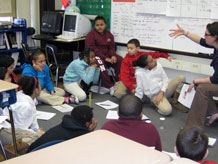How does water compare with sand?
4. Make meaning
Remind students that this is the second investigation in a row where measurement data were actually different than what might have been expected. Direct their attention to the class table: three groups started with the same weight of sand but the measured volumes were not always the same.
Purpose of the discussion
The purpose of this discussion is for students to jointly construct explanations regarding the discrepant sand and water data they have collected, explanations that are consistent with their observations and evidence.

Engage students in the focus question
Our data show that when water samples have equal weights, the measured volumes are not always equal. The same is true for sand. What are some possible explanations?
- The scales round measurements to the nearest gram
- There are limits to how accurately our eyes can see things.
- The way the water surface curves up when it touches the wall of the graduated cylinder makes it difficult to read the exact volume.
- When measuring the volume of sand, the surface is not perfectly flat, so it's difficult to see what the exact volume is.
- When the volume is more than 100cc's it has to be measured in two parts, because our graduated cylinders hold just 100cc. The small errors for each measurement are combined.
- Measure very carefully to avoid the errors that are possible to avoid.
- Make the same measurement twice, or have two different people make a measurement.
Summarize the discussion and recap the investigation
Using the same language students have used, summarize their main ideas. Include the following key ideas:
- Small errors are just a part of measurement and very difficult to avoid.
- Some errors are caused by the equipment we use.
- Some errors occur because our eyes cannot see exactly what the measurement really is.
As you recap the investigation, be sure there is understanding of these points:
- 1g of water has a volume of 1cc and 1g of sand has a volume that is less than 1cc.
- 1 cc of water weighs 1g and 1cc of sand weighs more than 1g.
- Both sand and water are matter because they have weight and take up space.
- Small measurement errors are almost always present. Realizing this means we can be more prepared to notice patterns even when there are small variations in the data. For example, we realize that 1g of water has a volume of 1cc, even though some of the values for volume did not exactly match the values for weight.
Reminder: Introduce 315 Dots Per Page
Don‘t forget a 5 minute introduction to 315 Dots per Page prior to Investigation 4.



